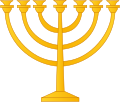
Back Orthodoxes Judentum ALS يهودية أرثوذكسية Arabic يهوديه ارثوذكسيه ARZ Xudaísmu ortodoxu AST Ortodoks iudaizm Azerbaijani Ортодоксален юдаизъм Bulgarian Ortodoksiezh yuzev Breton Judaisme ortodox Catalan Ortodoxní judaismus Czech Ortodoks jødedom Danish
This article needs additional citations for verification. (January 2025) |
 Jewish cemetery of the separate Orthodox community in Budapest, c. 1920. The Word "Orthodox" (ארטאדאקסען) inscribed in Hebrew letters, second from the left. | |
| Total population | |
|---|---|
| 2+ million practicing, ~4-5 million affiliated | |
| Founder | |
| Moses Sofer and other 19th-20th century traditionalist leaders | |
| Regions with significant populations | |
| 1 million (strictly observant) – 2.2 million (identifying)[1] | |
| ~500,000[2] | |
| ~150,000[3] | |
| Religions | |
| Judaism | |
| Scriptures | |
| Torah, Talmud | |
| Languages | |
| Hebrew, Yiddish | |
| Related ethnic groups | |
| Hasidic Judaism, Dati Leumi | |
| The population numbers are estimates based on observant members. | |
| Part of a series on |
| Judaism |
|---|
   |
Orthodox Judaism is a collective term for the traditionalist branches of contemporary Judaism. Theologically, it is chiefly defined by regarding the Torah, both Written and Oral, as literally revealed by God on Mount Sinai and faithfully transmitted ever since.
Orthodox Judaism therefore advocates a strict observance of Jewish Law, or halakha, which is to be interpreted and determined only according to traditional methods and in adherence to the continuum of received precedent through the ages. It regards the entire halakhic system as ultimately grounded in immutable revelation, essentially beyond external and historical influence. More than any theoretical issue, obeying the dietary, purity, ethical and other laws of halakha is the hallmark of Orthodoxy. Practicing members are easily distinguishable by their lifestyle, refraining from doing numerous routine actions on the Sabbath and holidays, consuming only kosher food, praying thrice a day, studying the Torah often, donning head covering and tassels for men and modest clothing for women, and so forth. Other key doctrines include belief in a future bodily resurrection of the dead, divine reward and punishment for the righteous and the sinners, the Election of Israel as a people bound by a covenant with God, and an eventual reign of a salvific Messiah who will restore the Temple in Jerusalem and gather the people to Zion.
Orthodox Judaism is not a centralized denomination. Relations between its different subgroups are often strained, and the exact limits of Orthodoxy are subject to intense debate. Very roughly, it may be divided between the Haredi (ultra-Orthodox) branch, which is more conservative and reclusive, and the Modern Orthodox, which is relatively open to outer society and partakes in secular life and culture. Each of those is itself formed of independent communities. These are almost uniformly exclusionist, regarding Orthodoxy as the only legitimate form of Judaism.
While adhering to traditional beliefs, the movement is a modern phenomenon. It arose as a result of the breakdown of the autonomous Jewish community since the late 18th century, and was much shaped by a conscious struggle against the pressures of secularization, acculturation and rival alternatives. The strictly observant Orthodox are a definite minority among all Jews, but there are also numerous semi- and non-practicing persons who are affiliated or personally identify with Orthodox communities and organizations. In total, Orthodox Judaism is the largest Jewish religious group, estimated to have over 2 million practicing adherents, and at least an equal number of nominal members or self-identifying supporters.
- ^ The 2016 Pew survey found that 22% of adult Jewish Israelis were dati or haredi, and 50% identified as Orthodox when asked. Adult Jewish population in Israel is roughly 4.5 million. See "demographics".
- ^ The 2013 Pew survey found out that 10% of adult American Jews identify as Orthodox, of a population of 4.2-5.3 million.
- ^ The 2016 synagoge survey found that 70% of British households with a membership (56,000 of 80,000) were Orthodox. With almost zero intermarriage, 120,000 is thus the minimum.